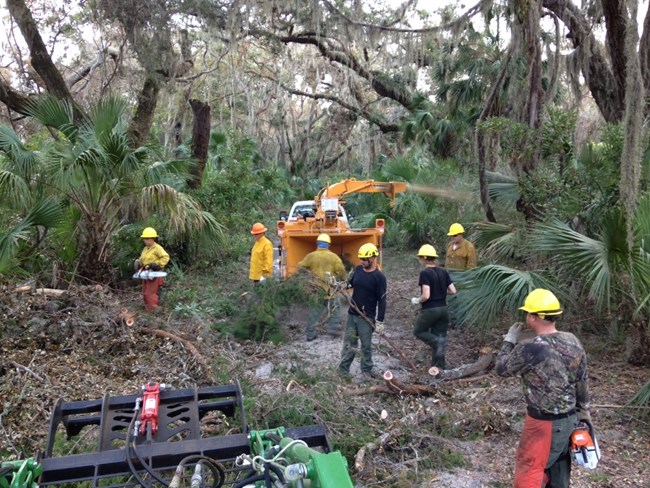Read more about the effects of 2017 storms on national parks below. Information about current severe weather and 2018 storms is also available.
Hurricane Nate
October 2017
Hurricane Nate made landfall along the central U.S. Gulf coast on Saturday, October 7, 2017. As a tropical depression, Nate moved north across the southeast states and the southern Appalachians. Updates from parks in the path of the storm were posted by the individual parks on their websites and social media pages.
- Gulf Islands National Seashore (MS, FL)
- Jean Lafitte National Historical Park and Preserve (LA)
- New Orleans Jazz National Historical Park (LA)
- Cane River Creole National Historical Park (LA)
- Great Smoky Mountains National Park (TN, NC)
- Blue Ridge Parkway (NC, VA)
For information about other parks in affected areas, use the Find A Park map to search by state.

NPS photo
Hurricanes Irma and Maria
September 2017
From September 6 through September 12, 2017, Hurricane Irma carved a path of destruction from the Caribbean, along the Florida peninsula, and into other areas of the southeastern United States, including coastal Georgia and South Carolina. A second powerful storm, Hurricane Maria, moved across the U.S. Virgin Islands and Puerto Rico on September 20, bringing catastrophic wind and rain to the Caribbean parks. The immediate NPS response was coordinated by NPS Incident Management Teams.
Posted below are updates about park recovery efforts, openings, and other aspects of the NPS response to and recovery from Hurricanes Irma and Maria.
Hurricane Harvey
August 2017
In the early morning of August 26, 2017, Hurricane Harvey struck the Texas coast and for the next several days meandered over parts of southeast Texas and southern Louisiana, bringing torrential rain and causing catastrophic flooding. In response to the storm, the NPS provided assistance at a number of national park units in Texas and Louisiana and support for other Department of the Interior bureaus. Some parks sustained damage to trails and facilities. The NPS also supported a number of mission assignments with the Federal Emergency Management Agency supporting survivors in Texas. For the response to Harvey, the NPS sent rangers and other staff from more than 43 different locations to support search and rescue, public safety and security, and damage assessments there.
Other Federal Resources and Information
- The Federal Emergency Management Agency (Department of Homeland Security) (Español) is the lead agency for the federal response to severe weather emergencies.
- USA.gov provides links to the latest available information on relief and response, including storm preparedness, helping survivors, and other resources. (GobiernoUSA.gov también provee información del gobierno en español.)
- For information about tropical weather that may be affecting a park near you, please visit the National Hurricane Center of the National Oceanic and Atmospheric Administration. The center issues watches, warnings, forecasts, and analyses of tropical weather.
NPS Policy and Authorities
NPS emergency response efforts are directed by NPS Management Policies, which state, “The saving of human life will take precedence over all other management actions as the National Park Service strives to protect human life and provide for injury-free visits” (Section 8.2.5.1, Visitor Safety and Emergency Response). The NPS ability to respond to incidents is essential to the safety of all who enter NPS areas and is implemented in this policy.
The NPS also has authority to support emergency response outside of the parks. During times of emergency, the NPS may be asked to provide response to conduct search and rescue, firefighting, or public safety and security. The NPS can provide support for needs involving public works and engineering, public health and medical services, oil and hazardous spill response, and external affairs. In addition, the NPS is one of the support agencies to provide natural and cultural resources and historic preservation functions in the federal government under the National Response Framework.
Last updated: July 11, 2019
